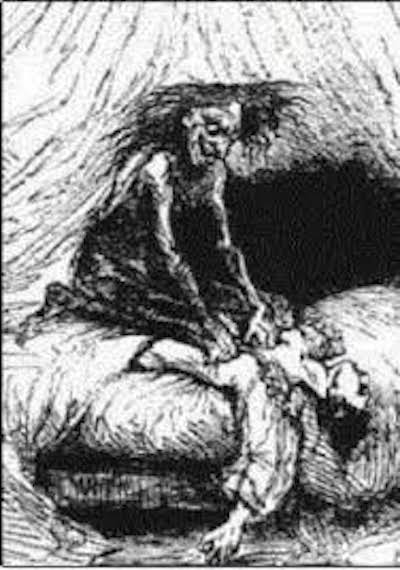Canadian Urban Legends: Newfoundlanders Can Tell You All About the Old Hag
Writing about urban legends can be a tricky business because there is no way to guarantee the facts. By nature, the stories operate in the shadows, feeding off misinformation, rumours, and furtive glances. Therefore, it’s a rare thing to find an urban legend that is so thoroughly examined and explained by science.
Newfoundlanders call her the Old Hag, but scientists call it sleep paralysis. One name is a lot spookier than the other, but neither can compare to the feeling of terror that comes from waking up to find her crouched on your chest and leering over you in the darkness.
Newfoundland is home to many legends and fairy stories that connect it to the Celtic vein that runs through the rock. But while many of its traditions are whimsical and beautiful like will-o’-the-wisps, this one is sinister and spoken of only in hushed tones even by people who don’t believe in ghost stories. Because, despite what science may call it, it’s undeniably strange that so many people in one geographic region report identical experiences.
Starting in the 1890s, when a small piece mentioning the Hag in Newfoundland appeared in the Journal of American Folklore, the world became aware that a strong belief and superstition had taken root in the province. Over the years, the Memorial University of Newfoundland Folklore and Language Archive (MUNFLA) has collected people’s accounts of their experiences with the Hag and the ways they rid themselves of her.
It’s undeniably strange that so many people in one geographic region report identical experiences.
David J. Hufford, an employee of MUNFLA from 1971 to 1974, wrote a book dedicated to his research around the Hag. She is described as a witch-like, wrinkled, and withered old woman with long hair. She can appear in doorways, be next to the bed, or even crawl on top of people and sit on them or pin them down. The legend is so pervasive that locals have turned to using her name as a verb to describe their experience: “I was hagged last night,” “the hagging happened two nights ago,” or “I got hag-ridden.” Hufford reports that people thought they could summon the hag by reciting the Lord’s Prayer backwards and kill her by sleeping on their backs with knifes or boards with upright nails against their chests designed to stab her when she sits on them. One victim of the Hag even accused another person in the community of “hagging him” (summoning the Hag to haunt a third party) out of jealousy.

Contemporary Newfoundland folklorist Dale Jarvis confirms that people still believe in the Old Hag today, and they approach the legend differently than others. He is a big fan of ghost stories (having written a few books on the subject) and asks locals about their encounters or if they believe in ghosts. Most say no. He always counters with, Have you heard of the Old Hag? People who scoffed at the idea of the supernatural reply, “Oh yes, my son had an experience,” and proceed to tell him a very creepy story. For the people of Newfoundland, the Hag exists outside the realm of fairies and goblins; it is a real and present danger that people experience.
Have you heard of the Old Hag? People who scoffed at the idea of the supernatural reply, “Oh yes, my son had an experience,” and proceed to tell him a very creepy story.
This may be due to the fact that it is a scientifically acknowledged problem that affects 8 per cent of the general population. Sleep paralysis is a horrible combination of hallucination and lack of muscle control caused by entering REM sleep too quickly. When we are asleep, we have limited control over our muscle groups and we dream. During sleep paralysis, the body and muscles are in REM sleep, but the mind is partially conscious, which can cause waking nightmare. Scientists believe it is the fear response and the brain trying to make sense of the immobilization that conjures the images of witches or a presence in the room. They cannot explain why everyone sees the same thing, though. Their solution to getting rid of the Hag? Get more sleep. Sleep paralysis is more likely to occur when you’re sleep deprived—sort of a vicious circle when you’re too scared to nod off for fear of a visit from the Hag.
Part of a series on Canadian Urban Legends. Read more HERE.




